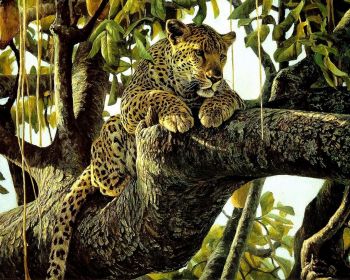Difference between revisions of "Leopard"
Tao alexis (talk | contribs) |
Tao alexis (talk | contribs) |
||
| Line 12: | Line 12: | ||
| HD = 3+2 | | HD = 3+2 | ||
| AP = 6 | | AP = 6 | ||
| + | | stride =21 | ||
| THAC0 = 18 | | THAC0 = 18 | ||
| hpdie = d8 | | hpdie = d8 | ||
| attack = claw/claw, bite | | attack = claw/claw, bite | ||
| dmg = 1–4/1–4, 2–8 | | dmg = 1–4/1–4, 2–8 | ||
| − | | special = [[Raking (attack)|rake]], [[Surprise (combat)|surprise]] on a 1–3,<br>surprised only on a 1 | + | | special = [[Jump (attack)|leap]], [[Raking (attack)|rake]], [[Surprise (combat)|surprise]] on a 1–3,<br>surprised only on a 1 |
}} | }} | ||
| − | The '''leopard''' | + | The '''leopard''' in its different species occurs in a wide range across different climates; most notable are the snow leopard (or Amur leopard), the Javan leopard, the black panther, the Arabian leopard and the commonly known African leopard. They possess a fur that is soft to the touch, varying from nearly white to yellowish and dark golden, with dark spots in rosettes. The fur grows longer in northern climates. In most climates the animal is well camouflages, enabling it to '''surprise''' creatures in the wild with alacrity. |
| − | + | The male is about 40% larger than the female, though both have the same number of hit dice. Both have relatively short legs and a long body, with a large skull. It is a solitary animal, with the male and female separating after mating with the raising of cubs left to the female. If raised from a cub, they can be quite tame and are often kept as pets. | |
| + | == Advantages == | ||
| + | Leopards can climb trees very skillfully, often resting on tree branches and descending from trees headfirst. When a leopard attacks, at the end of its rush it will '''leap four [[Combat Hex|combat hexes]]''' following its movement, enabling it to close the distance quickly with its prey. It is able to perform this leap between trees, prior to dropping down on and surprising opponents from an initial, hidden location. | ||
| − | The | + | The leopard attacks with their jaws and forepaws. If the leopard strikes with both forepaws, it will then get two additional attacks, '''raking''' with the rear claws, each causing 1-6 damage. |
| − | The | + | The leopard is very observant in its habitat and can be '''surprised only on a 1 in 6'''. |
| − | |||
| − | |||
| − | |||
| − | |||
| − | |||
Revision as of 01:25, 24 August 2020
| Species | feline |
| No. Appearing | 1–2 |
| Behaviour | presocial |
| Range | alpine, desert, jungle, rainforest, savanna, steppe, veldt, woodland |
| Size | 28 in. at the shoulder |
| Weight | 190 lbs. |
| Intelligence | 3 |
| Armour Class | 6 |
| Hit Dice | 3+2 |
| Action Points | 6 |
| Max. Stride | 21 |
| THAC0 | 18 |
| Hp/Die | d8 |
| Attack Forms | claw/claw, bite |
| Damage | 1–4/1–4, 2–8 |
| Special Attacks | leap, rake, surprise on a 1–3, surprised only on a 1 |
The leopard in its different species occurs in a wide range across different climates; most notable are the snow leopard (or Amur leopard), the Javan leopard, the black panther, the Arabian leopard and the commonly known African leopard. They possess a fur that is soft to the touch, varying from nearly white to yellowish and dark golden, with dark spots in rosettes. The fur grows longer in northern climates. In most climates the animal is well camouflages, enabling it to surprise creatures in the wild with alacrity.
The male is about 40% larger than the female, though both have the same number of hit dice. Both have relatively short legs and a long body, with a large skull. It is a solitary animal, with the male and female separating after mating with the raising of cubs left to the female. If raised from a cub, they can be quite tame and are often kept as pets.
Advantages
Leopards can climb trees very skillfully, often resting on tree branches and descending from trees headfirst. When a leopard attacks, at the end of its rush it will leap four combat hexes following its movement, enabling it to close the distance quickly with its prey. It is able to perform this leap between trees, prior to dropping down on and surprising opponents from an initial, hidden location.
The leopard attacks with their jaws and forepaws. If the leopard strikes with both forepaws, it will then get two additional attacks, raking with the rear claws, each causing 1-6 damage.
The leopard is very observant in its habitat and can be surprised only on a 1 in 6.
See Bestiary
